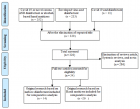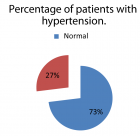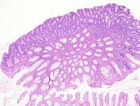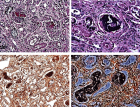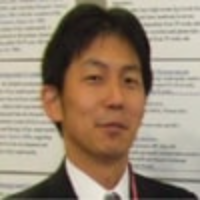Abstract
Research Article
Phytochemical Compounds and the Antifungal Activity of Centaurium pulchellum Ethanol Extracts in Iraq
Noor Jawad Khadhum, Neepal Imtair Al-Garaawi* and Antethar Jabbar Al-Edani
Published: 25 June, 2024 | Volume 8 - Issue 2 | Pages: 079-083
The current study included a variety of phytochemical substances that were extracted from Centaurium pulchellum and showed a wide range of medicinal properties from the plant's reproductive and vegetative parts against the pathogenic fungus Aspergillus flavus. The vegetative and reproductive components of Centaurium pulchellum were subjected to (GC-MS) analysis for phytochemical study. The data indicated that fungal activity was the highest. Four extract concentrations of 5, 10, 15, and 20 mg/ml were utilized in the investigation, and the diameter of the colonies measured at each concentration was 90.00, 36.00, 28.00, 18.00, and 0.00 mm, respectively.
Nine bioactive phytochemical compounds were found in Centaurium pulchellum's vegetative and reproductive portions, according to GC-MS analysis of the chemicals. Another study reported phytochemical substances that: 1-H-Imidazole-2-carboxaldehyde, 1-methyl-;Acetaminophen; n-Hexadecanoic acid; Mercaptoacetic acid, 2TMS derivative; 1.2,3-Dimethyl-5-(trifluoromethyl)-1,4-benzenediol #; Mercaptoethanol, 2TMS derivative-; Bis-(3,5,5-trimethylhexyl) phthalate Tetrakis(trimethylsilyl) orthosilicate #;- 1.1-Isopropoxy-3,3,3-trimethyl-1-[(trimethylsilyl)oxy]disiloxanyl tris(trimethylsilyl) orthosilicate #.
Read Full Article HTML DOI: 10.29328/journal.jpsp.1001137 Cite this Article Read Full Article PDF
Keywords:
Pulchellum centaurium; Phytochemical; Gas chromatography-mass spectrometry; Antifungal
References
- Ressources U. internationale pour la conservation de la nature et de ses. A guide to medicinal plants in North Africa. IUCN; 2005.
- Ghazanfar S, Edmondson JR. Flora of Iraq.Lythyraceae to Camanulaceae Ministry of Agriculture Republic of Iraq.vol.5.part 2.p28. 2013.
- Al-Allaq SA, AL-Mossawei AH, Alzhra LA. Species of Centaurium Hill. In Iraq and its geographical distribution. Baghdad Science Journal. 2013; 10(1):22-31.
- Mifsud S. Centaurium pulchellum (Lesser Centaury): MaltaWildPlants. Com-the online Flora of the Maltese Islands. 2002.
- Saeed JF. Morphological Study of the Centaurium pulchelum and C. erythraea (Gentianaceae) in Kurdistan region of Iraq. Education. 2013; 7(1):01-06.
- Ubsdell RAE. Studies on variation and evolution in Centaurium erythraea Rafn and C. littorale (D. Turner) Gilmour in the British Isles. 3. Breeding systems, floral biology, and general discussion. Watsonia. 1979; 12:225-232.
- Krstić D, Janković T, Šavikin-Fodulović K, Menković N, Grubiŝić D. Secoiridoids and xanthones in the shoots and roots of Centaurium pulchellum cultured in vitro. In Vitro Cellular & Developmental Biology-Plant. 2003;3 9:203-207.
- van der Sluis WG. Chemotaxonomical investigations of the genera Blackstonia and Centaurium (Gentianaceae). Plant Systematics and Evolution. 1985; 149:253-286.
- Bibi H, Ali I, Sadozai SK, Atta-Ur-Rahman. Phytochemical studies and antibacterial activity of Centaurium pulchellum Nat Prod Res. 2006 Aug ;20(10):896-901. doi: 10.1080/14786410500162047. PMID: 16854716.
- Siler B, Misić D, Nestorović J, Banjanac T, Glamoclija J, Soković M, Cirić A. Antibacterial and antifungal screening of Centaurium pulchellum crude extracts and main secoiridoid compounds. Nat Prod Commun. 2010 Oct;5(10):1525-30. PMID: 21121240.
- Siler B, Zivković S, Banjanac T, Cvetković J, Nestorović Živković J, Cirić A, Soković M, Mišić D. Centauries as underestimated food additives: antioxidant and antimicrobial potential. Food Chem. 2014 Mar 15;147:367-76. doi: 10.1016/j.foodchem.2013.10.007. Epub 2013 Oct 11. PMID: 24206732.
- Todorović M, Milutinović M, Božunović J, Aničić N, Petrović L, Skorić M, Mišić D. Comparative metabolomics of two Centaurium species displaying variable flower coloration phenotypes. In 4th International Conference on Plant Biology [and] 23rd SPPS Meeting; 2022 Oct 6-8; Belgrade, Serbia. Belgrade: Institute for Biological Research" Siniša Stanković"–National Institute of Republic of Serbia, University of Belgrade. 2022; 145.
- Tan RX, Kong LD, Wei HX. Secoiridoid glycosides and an antifungal anthranilate derivative from Gentiana tibetica. Phytochemistry. 1998 Apr;47(7):1223-6. doi: 10.1016/s0031-9422(97)00698-5. PMID: 9611826.
- Cho HJ, Son SH, Chen W, Son YE, Lee I, Yu JH, Park HS. Regulation of Conidiogenesis in Aspergillus flavus. Cells. 2022 Sep 7;11(18):2796. doi: 10.3390/cells11182796. PMID: 36139369; PMCID: PMC9497164.
- Szepietowski JC, Schwart RA. Tineabarbae. Umdnj-New Jersey medical school.
- Ayman Y El-Khateeb, Elsherbiny A Elsherbiny , Louis K Tadros , Safaa M Ali and Hassan B Hamed.(2013) . Phytochemical Analysis and Antifungal Activity of Fruit Leaves Extracts on the Mycelial Growth of Fungal Plant Pathogens. J Plant Pathol Microb. Vol 4 , Isse 9 • 1000199
- Champion R, Burton J, Burns D, Breathnach S. Textbook of dermatology. 6th ed. Oxford: Blackwell Science Ltd; 1998. p. 1277-1376.
- Wahid AZ, Jafar FN. Test of life effectiveness of Carthamus tinctorius extract toward germ and fungi. AlBasrah Res J. 2005;31(3B):39-47.
- El-Kady IA, Mohamed SS, Mostafa EM. Antibacterial and anti-dermatophyte activities of some essential oils from spices. Qatar Univ Sci J. 1993;13(1):63-69.
- Gahukar RT. Evaluation of plant-derived products against pests and diseases of medicinal plants: A review. Crop Prot. 2012;42:202-20.
- Al-Zahraa Center for Medical and Pharmaceutical Research Sciences (ZCMPRS) Email: zcmprs@alzahraa.edu.iq.
- Janković T, Krstić D, Savikin-Fodulović K, Menković N, Grubisić D. Xanthones and secoiridoids from hairy root cultures of Centaurium erythraea and C. pulchellum. Planta Med. 2002 Oct;68(10):944-6. doi: 10.1055/s-2002-34927. PMID: 12391565.
- Miana GA, Al-Hazimi HMG. Xanthones of Centaurium pulchellum. Phytochemistry. 1984; 23:1637-1638.
- Militello M, Settanni L, Aleo A, Mammina C, Moschetti G, Giammanco GM, Blàzquez MA, Carrubba A. Chemical composition and antibacterial potential of Artemisia arborescens L. essential oil. Curr Microbiol. 2011 Apr;62(4):1274-81. doi: 10.1007/s00284-010-9855-3. Epub 2010 Dec 25. PMID: 21188586.
- Kumaradevan G, Damodaran R, Mani P, Dineshkumar G, Jayaseelan T. Phytochemical screening and GC-MS analysis of bioactive components of ethanol leaves extract of Clerodendrum phlomidis (L). Am J Biol Pharm Res. 2015;2:142-148.
- Li M, Zhou L, Yang D, Li T, Li W. Biochemical composition and antioxidant capacity of extracts from Podophyllum hexandrum rhizome. BMC Complement Altern Med. 2012 Dec 22;12:263. doi: 10.1186/1472-6882-12-263. PMID: 23259745; PMCID: PMC3542176.
- AlAmery SF, AlGaraawi NI. Phytochemical profile and antifungal activity of stems and leaves methanol extract from the Juncus maritimus Linn. Juncaceae family against some dermatophytes fungi. AIP Conf Proc. 2020;2290:020034-1–020034-17.
- Al-Garaawi NI, et al. Analysis of bioactive phytochemical compound of Cyperus alternifolius L. by using gas chromatography-mass spectrometry. IOP Conf Ser Mater Sci Eng. 2019;571(1):1-19.
Figures:
Similar Articles
-
Phytochemical content of leaf and stem of Marsilea quadrifolia (L.)Rajangam Udayakumar*,Karikalan Gopalakrishnan. Phytochemical content of leaf and stem of Marsilea quadrifolia (L.). . 2017 doi: 10.29328/journal.jpsp.1001003; 1: 026-037
-
Food applications of Aloe species: A reviewAdamu Tizazu Yadeta*. Food applications of Aloe species: A review. . 2022 doi: 10.29328/journal.jpsp.1001070; 6: 024-032
-
Phytochemical and pharmacological properties of Jatropha dioicaDiana Isela Araujo-Espino,Blanca Patricia Lazalde-Ramos*,Ana Lourdes Zamora-Perez. Phytochemical and pharmacological properties of Jatropha dioica. . 2023 doi: 10.29328/journal.jpsp.1001098; 7: 010-013
-
Determination of the Potential for use of Plant Essential Oils as a Fungicide Against Fusarium Oxysporum (OG10)Elif Tan*, Ebru Gezgincioğlu, Özlem Gülmez and Özlem Barış. Determination of the Potential for use of Plant Essential Oils as a Fungicide Against Fusarium Oxysporum (OG10). . 2023 doi: 10.29328/journal.jpsp.1001114; 7: 107-112
-
GS-MS Profile, Total Flavonoid and Phenolic Contents and Antioxidant Capacity of Leaves of Vitelleria paradoxa c.f. GaertnTheresa Ibibia Edewor*, Amuda Mutiu Olasunkanmi, Stephen Oluwagbemiga Owa. GS-MS Profile, Total Flavonoid and Phenolic Contents and Antioxidant Capacity of Leaves of Vitelleria paradoxa c.f. Gaertn. . 2024 doi: 10.29328/journal.jpsp.1001131; 8: 043-047
-
Phytochemical Compounds and the Antifungal Activity of Centaurium pulchellum Ethanol Extracts in IraqNoor Jawad Khadhum, Neepal Imtair Al-Garaawi*, Antethar Jabbar Al-Edani. Phytochemical Compounds and the Antifungal Activity of Centaurium pulchellum Ethanol Extracts in Iraq. . 2024 doi: 10.29328/journal.jpsp.1001137; 8: 079-083
Recently Viewed
-
Parents’ perception of the school nurse’s roleDiane Gillooly*,Ganga Mahat,Patricia Paradiso. Parents’ perception of the school nurse’s role. J Adv Pediatr Child Health. 2020: doi: 10.29328/journal.japch.1001021; 3: 064-067
-
Plant growth, Yield and Leaf Nutritional value of Jute (Corchorus olitorius L.) as Influenced by Banana Peel levels under Salt Stress conditions in Coastal region of CameroonMathias Julien Hand*,Chimène Fanta Abib,Kingsley Mbi Tabi,Alphonse Ervé Nouck,Libert Brice Tonfack,Victor Désiré Taffouo,Emmanuel Youmbi. Plant growth, Yield and Leaf Nutritional value of Jute (Corchorus olitorius L.) as Influenced by Banana Peel levels under Salt Stress conditions in Coastal region of Cameroon. J Plant Sci Phytopathol. 2024: doi: 10.29328/journal.jpsp.1001145; 8: 131-140
-
Dynamics of Siberian Fir Stands in Forest Ecosystems of Eastern Sayan SpursBazhina Elena Vasil’evna*,Pavel I Aminev. Dynamics of Siberian Fir Stands in Forest Ecosystems of Eastern Sayan Spurs. J Plant Sci Phytopathol. 2024: doi: 10.29328/journal.jpsp.1001146; 8: 141-143
-
Minimising Carbon Footprint in Anaesthesia PracticeNisha Gandhi and Abinav Sarvesh SPS*. Minimising Carbon Footprint in Anaesthesia Practice. Int J Clin Anesth Res. 2024: doi: 10.29328/journal.ijcar.1001025; 8: 005-007
-
Survey of Advanced Image Fusion Techniques for Enhanced Visualization in Cardiovascular Diagnosis and TreatmentGargi J Trivedi*. Survey of Advanced Image Fusion Techniques for Enhanced Visualization in Cardiovascular Diagnosis and Treatment. J Clin Med Exp Images. 2025: doi: 10.29328/journal.jcmei.1001034; 9: 001-009
Most Viewed
-
Evaluation of Biostimulants Based on Recovered Protein Hydrolysates from Animal By-products as Plant Growth EnhancersH Pérez-Aguilar*, M Lacruz-Asaro, F Arán-Ais. Evaluation of Biostimulants Based on Recovered Protein Hydrolysates from Animal By-products as Plant Growth Enhancers. J Plant Sci Phytopathol. 2023 doi: 10.29328/journal.jpsp.1001104; 7: 042-047
-
Sinonasal Myxoma Extending into the Orbit in a 4-Year Old: A Case PresentationJulian A Purrinos*, Ramzi Younis. Sinonasal Myxoma Extending into the Orbit in a 4-Year Old: A Case Presentation. Arch Case Rep. 2024 doi: 10.29328/journal.acr.1001099; 8: 075-077
-
Feasibility study of magnetic sensing for detecting single-neuron action potentialsDenis Tonini,Kai Wu,Renata Saha,Jian-Ping Wang*. Feasibility study of magnetic sensing for detecting single-neuron action potentials. Ann Biomed Sci Eng. 2022 doi: 10.29328/journal.abse.1001018; 6: 019-029
-
Pediatric Dysgerminoma: Unveiling a Rare Ovarian TumorFaten Limaiem*, Khalil Saffar, Ahmed Halouani. Pediatric Dysgerminoma: Unveiling a Rare Ovarian Tumor. Arch Case Rep. 2024 doi: 10.29328/journal.acr.1001087; 8: 010-013
-
Physical activity can change the physiological and psychological circumstances during COVID-19 pandemic: A narrative reviewKhashayar Maroufi*. Physical activity can change the physiological and psychological circumstances during COVID-19 pandemic: A narrative review. J Sports Med Ther. 2021 doi: 10.29328/journal.jsmt.1001051; 6: 001-007

HSPI: We're glad you're here. Please click "create a new Query" if you are a new visitor to our website and need further information from us.
If you are already a member of our network and need to keep track of any developments regarding a question you have already submitted, click "take me to my Query."






